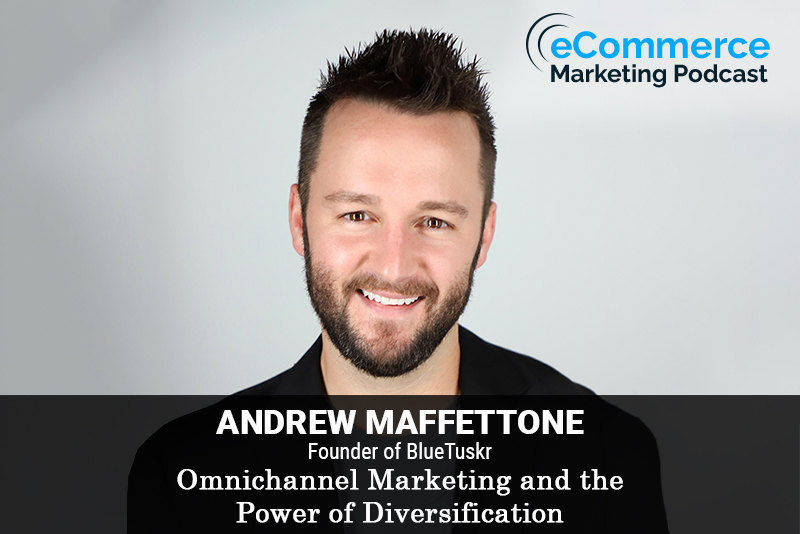
The eCommerce Marketing Podcast walks you through everything that goes into ecommerce marketing — from inbound marketing to paid advertising to conversions. Learn the strategies top marketing experts use to grow their businesses.
Andrew is an e-commerce marketing expert with over 15 years in the industry, he is the Founder of BlueTuskr, a full-service marketing company for e-commerce sellers and the host of The E-Comm Show podcast.
In this episode, you will learn
What is omnichannel marketing is and why it’s so crucial for e-commerce businesses today
What are the key channels that e-commerce sellers should consider when implementing an omnichannel marketing strategy? How do they differ in terms of audience and potential reach?
How do you approach measuring the success of an omnichannel marketing strategy? What metrics or KPIs should businesses pay attention to
How can e-commerce sellers effectively leverage omnichannel marketing to diversify off of traditional marketplaces like Amazon and eBay?
How do you approach measuring the success of an omnichannel marketing strategy? What metrics or KPIs should businesses pay attention to?
Success stories of businesses that have thrived by diversifying off marketplaces through omnichannel marketing?
For show transcript and past guests, please visit https://www.ecommercemarketingpodcast.com
Or on YouTube at:
https://www.youtube.com/channel/UC3PgT0NOGzpdPGQtBK0XLIQ
Follow Arlen:
Twitter: https://twitter.com/askarlen
Facebook: https://www.facebook.com/arlen.robinson.7
Instagram: https://www.instagram.com/arlenyohance/
LinkedIn: https://www.linkedin.com/in/arlenrobinson/
Past guests on the ecommerce marketing podcast include Neil Patel, Nemo Chu, Luke Lintz, Luke Carthy, Amber Armstrong, Kris Ruby and many more.
Thanks for listening. Be sure to subscribe and leave a review.

Title: Enhancing E-commerce with Omni-Channel Marketing featuring Andrew Maffettone
Guest: Andrew Maffettone, Founder of BlueTuskr
Host: Arlen Robinson
In this episode of the eCommerce Marketing Podcast, host Arlen Robinson interviews Andrew Maffettone, an e-commerce marketing expert with over 15 years of experience and the founder of BlueTuskr, a full-service marketing company for e-commerce sellers. Andrew shares his insights on the importance of omni-channel marketing and how to effectively diversify your presence across multiple sales channels.
Key Takeaways:
- [2:30] Introduction to Andrew Maffettone:
- Andrew’s extensive background in e-commerce marketing.
- The founding of BlueTuskr and its role as a full-service marketing company.
- [5:00] What is Omni-Channel Marketing?:
- Ensuring marketing is relevant across all sales channels where customers shop.
- Treating different sales channels as interconnected rather than separate entities.
- [7:30] Importance of Diversifying Sales Channels:
- Focusing on major channels like Amazon and Shopify.
- Exploring other platforms like Walmart, eBay, and specialized marketplaces.
- [10:45] Key Metrics for Omni-Channel Success:
- Looking at overall ROI of marketing spend versus revenue.
- Tracking holistic performance rather than isolated channel metrics.
- [15:00] Managing Traffic Between Channels:
- Using tactics like an “available on Amazon” button to guide customers efficiently.
- Implementing tracking mechanisms to retarget customers and gather data.
- [18:30] Balancing DTC and Marketplace Sales:
- Evaluating the benefits of higher conversion rates on platforms like Amazon.
- Testing and analyzing to determine the most effective sales strategies.
- [22:00] Case Study:
- Success story of a client who increased conversion rates by implementing omni-channel strategies, including Amazon’s Buy With Prime.
Guest Info:
- Andrew Maffettone
- Founder of BlueTuskr
- Website: BlueTuskr
- Social Media: LinkedIn, Instagram, Facebook, Twitter (@AndrewMaff)











